Supportive Business Environments to Develop Grass Bioeconomy in Europe
Abstract
1. Introduction
2. Materials and Methods
2.1. Case Study Selection
2.2. Case Study Selection
3. Results and Discussion
3.1. Business Environments of Grass-Based Businesses
3.1.1. Technology and Knowledge
3.1.2. Resources and Infrastructure
3.1.3. Training and Education
3.1.4. Market Development
3.1.5. Institutional Development
3.1.6. Consumer Development
3.1.7. Funding
4. Challenges and Limitations
5. Conclusions
6. Recommendations
Author Contributions
Funding
Acknowledgments
Conflicts of Interest
Appendix A
- Name of the business
- Grass-based product
- Biogeographical area/city/country
- Contact Information
- What kind of technology and knowledge does the business require?
- Can you rate the importance of this technology and knowledge for the business case?
- Is the business environment supportive for technology and knowledge development?
- Can you rate the level of supportiveness?
- What are the main sources of support for technology and knowledge?
- What are the critical factors for acquiring the technology and knowledge needed (from these sources) for starting and running your business?
- Have the businesses within the value chain access to financial sources?
- What are the main sources of funding?
- Which sources of funding are not reflected that could support the different businesses within the value chain? Please, justify your answer
- How do you rate the level of supportiveness of the business environment for funding?
- Which factors do you consider critical to obtain the necessary funding to start and run the business? Please, justify your answer
- How important is the supply and access to raw materials/resources for the business?
- What/who are the main sources of the raw materials?
- What are the critical factors for acquiring the raw materials/resources?
- How supportive is/was the business environment supportive the business to access these raw materials/resources? Please, justify your answer to the previous question
- What kind of infrastructures such as roads, forms of communication, water supply and/or other facilities are particularly relevant for the business to operate? Please, justify your answer
- Could you rate the importance of these infrastructures for the business case?
- What are the critical factors for acquiring the infrastructures?
- How supportive was the business environment supportive the business to access these infrastructures? Could you please justify your answer to the previous question?
- Does the business require more training and education?
- What type of training and education activities/programs support the business? What is missing?
- How supportive is the business environment in providing training and education opportunities?
- What are the critical factors for acquiring the training and education?
- Does the business environment support the market development of the business?
- What external factors or elements have had the strongest impact on the development of your business when it comes to market structures? Please, justify your answer
- How do you rate the importance of this market development for the business case?
- How do you rate the support from the business environment on market development? Please, justify your answer to the previous question.
- What factors are required for the market development of the business? Please, justify your answer
- What critical rules and regulations does your business need to fulfill to register and operate as a legal entity? Please, include *regulation identification and *original and *English translated tittle. Also *link in English if possible. (E.g., Directive 2000/60/EC—Marco comunitario de actuación en el ámbito de la política de aguas—Framework for Community action in the field of water policy—https://eur-lex.europa.eu/legal-content/EN/TXT/HTML/?uri=LEGISSUM:l28002b&from=ES accessed on 18 February 2021).
- How do you rate the support from the business environment for institutional development?
- Could you please justify your answer to the previous question?
- What are the critical factors for acquiring the needed support for institutional development (rules and regulations) for your business? Please, justify your answer
- Does the business require a change in consumers values and preferences?
- Could you please highlight and explain the external factors critical for shaping consumers values and perception?
- How do you rate the support of the business environment for consumers development? Could you please justify your answer to the previous question?
- Could you please highlight the critical factors for acquiring the support on changing consumer preferences and values? Please, justify your answer
Appendix B. Coding Scheme in Atlas.ti
| Category | Description | Example |
| Institutional Development | Rules and regulations related to grasslands and grass-based business models | “The ban on single use plastics is very supportive for the development of our business.” (Case #4) |
| Funding | Access to financial capital required for business development | “We received funding from the EU funded ECO Innovation project and other private investors.” (Case #6) |
| Market Development | Transactions between the enterprises and their customers | “Our strategy is to focus on long-term relationships with customers by providing after sale services.” (Case #6) |
| Consumer Development | Actions and interactions that shape individuals, organizations, and societies to make decisions towards bio-based products | “Growing demand for lightweight and innovative packaging with eco-friendly and recyclable product specifications.” (Case #2). |
| Technology and Knowledge | Generation of knowledge and dissemination of technical processes and tools. | “The business requires technology for improving conversion and biorefining processes and knowledge on how to extract fibers from the raw material in the most efficient way.” (Case #14). |
| Resources and Infrastructure | Availability of grass and basic physical structures | “Price and quality are highly influenced by distance. Usually a distance of 10 km distance from our raw material is expected.” (Case #7) |
| Training and Education | Development and transfer of skills that enhance the competitiveness of the business | “Expansive know-how is always required to improve our technologies and production systems.” (Case #1) |
References
- Jarre, M.; Petit-Boix, A.; Priefer, C.; Meyer, R.; Leipold, S. Transforming the Bio-Based Sector towards a Circular Economy—What Can We Learn from Wood Cascading? For. Policy Econ. 2020, 110, 101872. [Google Scholar] [CrossRef]
- Lange, L.; Connor, K.O.; Arason, S.; Bundgård-Jørgensen, U.; Canalis, A.; Carrez, D.; Gallagher, J.; Gøtke, N.; Huyghe, C.; Jarry, B.; et al. Developing a Sustainable and Circular Bio-Based Economy in EU: By Partnering Across Sectors, Upscaling and Using New Knowledge Faster, and For the Benefit of Climate, Environment & Biodiversity, and People & Business. Front. Bioeng. Biotechnol. 2021, 8, 619066. [Google Scholar] [CrossRef]
- Bengtsson, J.; Bullock, J.M.; Egoh, B.; Everson, C.; Everson, T.; O’Connor, T.; O’Farrell, P.J.; Smith, H.G.; Lindborg, R. Grasslands-More Important for Ecosystem Services than You Might Think. Ecosphere 2019, 10, e02582. [Google Scholar] [CrossRef]
- Estel, S.; Mader, S.; Levers, C.; Verburg, P.H.; Baumann, M.; Kuemmerle, T. Combining Satellite Data and Agricultural Statistics to Map Grassland Management Intensity in Europe. Environ. Res. Lett. 2018, 13, 74020. [Google Scholar] [CrossRef]
- European Commission. A Sustainable Bioeconomy for Europe: Strengthening the Connection Between Economy, Society and the Environment. Updated Bioeconomy Strategy; European Commission: Brussels, Belgium, 2018. [Google Scholar]
- European Commission. The European Green Deal COM (2012) 60 Final; European Commission: Brussels, Belgium, 2019. [Google Scholar]
- European Commission. A New Circular Economy Action Plan For a Cleaner and More Competitive Europe COM/2020/98 Final; European Commission: Brussels, Belgium, 2020. [Google Scholar]
- European Commission. EU Biodiversity Strategy for 2030; European Commission: Brussels, Belgium, 2020. [Google Scholar]
- Reinermann, S.; Asam, S.; Kuenzer, C. Remote Sensing of Grassland Production and Management—A Review. Remote Sens. 2020, 12, 1949. [Google Scholar] [CrossRef]
- Van Oudtshoorn, F. Grasses and Grassland Ecology: By David J Gibson. Afr. J. Range Forage Sci. 2010, 27, 63–64. [Google Scholar] [CrossRef]
- Frame, J.; Laidlaw, A.S. Improved Grassland Management, 2nd ed.; Crowood Press: Ramsbury, UK, 2011; ISBN 978-1-84797-261-3. [Google Scholar]
- McEniy, J.; O’Kiely, P. Developments in Grass-/Forage-Based Biorefineries. In Advances in Biorefineries; Elsevier: Amsterdam, The Netherlands, 2014; pp. 335–363. ISBN 978-0-85709-521-3. [Google Scholar]
- Zhao, Y.; Liu, Z.; Wu, J. Grassland Ecosystem Services: A Systematic Review of Research Advances and Future Directions. Landsc. Ecol. 2020, 35, 793–814. [Google Scholar] [CrossRef]
- Tura, N.; Hanski, J.; Ahola, T.; Ståhle, M.; Piiparinen, S.; Valkokari, P. Unlocking Circular Business: A Framework of Barriers and Drivers. J. Clean. Prod. 2019, 212, 90–98. [Google Scholar] [CrossRef]
- Vermunt, D.A.; Negro, S.O.; Verweij, P.A.; Kuppens, D.V.; Hekkert, M.P. Exploring Barriers to Implementing Different Circular Business Models. J. Clean. Prod. 2019, 222, 891–902. [Google Scholar] [CrossRef]
- Hans, V. Business Environment–Conceptual Framework and Polices. Int. Educ. Sci. Res. J. 2018, 4, 67–74. [Google Scholar]
- Adamseged, M.E.; Grundmann, P. Understanding Business Environments and Success Factors for Emerging Bioeconomy Enterprises through a Comprehensive Analytical Framework. Sustainability 2020, 12, 9018. [Google Scholar] [CrossRef]
- Phillips, M.A.; Ritala, P. A Complex Adaptive Systems Agenda for Ecosystem Research Methodology. Technol. Forecast. Soc. Chang. 2019, 148, 119739. [Google Scholar] [CrossRef]
- Suominen, A.; Seppänen, M.; Dedehayir, O. A Bibliometric Review on Innovation Systems and Ecosystems: A Research Agenda. Eur. J. Innov. Manag. 2019, 22, 335–360. [Google Scholar] [CrossRef]
- Alkemade, F.; Kleinschmidt, C.; Hekkert, M. Analysing Emerging Innovation Systems: A Functions Approach to Foresight. Int. J. Foresight Innov. Policy 2007, 3, 139. [Google Scholar] [CrossRef]
- Zott, C.; Amit, R. Business Model Design and the Performance of Entrepreneurial Firms. Organ. Sci. 2007, 18, 181–199. [Google Scholar] [CrossRef]
- Garud, R.; Kumaraswamy, A.; Karnøe, P. Path Dependence or Path Creation?: Path Dependence or Path Creation? J. Manag. Stud. 2010, 47, 760–774. [Google Scholar] [CrossRef]
- Rosenbloom, D. Pathways: An Emerging Concept for the Theory and Governance of Low-Carbon Transitions. Glob. Environ. Chang. 2017, 43, 37–50. [Google Scholar] [CrossRef]
- Sühlsen, K.; Hisschemöller, M. Lobbying the ‘Energiewende’. Assessing the Effectiveness of Strategies to Promote the Renewable Energy Business in Germany. Energy Policy 2014, 69, 316–325. [Google Scholar] [CrossRef]
- Voss, C.; Tsikriktsis, N.; Frohlich, M. Case Research in Operations Management. Int. J. Oper. Prod. Manag. 2002, 22, 195–219. [Google Scholar] [CrossRef]
- Yin, R.K. Case Study Research: Design and Methods, 4th ed.; Applied Social Research Methods; Sage Publications: Los Angeles, CA, USA, 2009; ISBN 978-1-4129-6099-1. [Google Scholar]
- Mosquera, R.; Santiago-Freijanes, J.J.; Ferreiro-Domingueu, N.; Rodriguez-Rigueiro, J. Report with the Maps of the Different Permanent Grassland; European Commission: Brussels, Belgium, 2020. [Google Scholar]
- World Bank. Doing Business 2018: Reforming to Create Jobs; World Bank: Washington, DC, USA, 2018; ISBN 978-1-4648-1146-3. [Google Scholar]
- Donor Committee for Enterprise Development. Supporting Business Environment Reforms: Practical Guide for Development Agencies; Donor Committee for Enterprise Development: PA, USA, 2008. [Google Scholar]
- Kristensen, P. The DPSIR Framework. In Proceedings of the 2004 Workshop on a Comprehensive/Detailed Assessment of the Vulnerability of Water Resources to Environmental Change in Africa Using River Basin Approach, Nairobi, Kenya, 27–29 September 2004. [Google Scholar]
- Miles, M.B.; Huberman, A.M.; Saldaña, J. Qualitative Data Analysis: A Methods Sourcebook, 4th ed.; SAGE: Los Angeles, CA, USA, 2020; ISBN 978-1-5063-5307-4. [Google Scholar]
- Cochrane, W.W. The Development of American Agriculture: A Historical Analysis, 2nd ed.; University of Minnesota Press: Minneapolis, MN, USA, 1993; ISBN 978-0-8166-2282-5. [Google Scholar]
- Falcon, W.P. Transforming Traditional Agriculture. Am. J. Agric. Econ. 1988, 70, 198–200. [Google Scholar] [CrossRef]
- Ghisellini, P.; Cialani, C.; Ulgiati, S. A Review on Circular Economy: The Expected Transition to a Balanced Interplay of Environmental and Economic Systems. J. Clean. Prod. 2016, 114, 11–32. [Google Scholar] [CrossRef]
- Smithers, J.; Blay-Palmer, A. Technology Innovation as a Strategy for Climate Adaptation in Agriculture. Appl. Geogr. 2001, 21, 175–197. [Google Scholar] [CrossRef]
- Adner, R.; Kapoor, R. Innovation Ecosystems and the Pace of Substitution: Re-Examining Technology S-Curves. Strateg. Manag. J. 2016, 37, 625–648. [Google Scholar] [CrossRef]
- Pahurkar, R.N. The Comprehensive Approach for Creativity and Innovation—Enhancement and Sustainability in Social Enterprises. J. Manag. Sustain. 2014, 4, 111. [Google Scholar] [CrossRef][Green Version]
- Bozeman, B. Technology Transfer and Public Policy: A Review of Research and Theory. Res. Policy 2000, 29, 627–655. [Google Scholar] [CrossRef]
- Shane, S. Executive Forum:University Technology Transfer to Entrepreneurial Companies. J. Bus. Ventur. 2002, 17, 537–552. [Google Scholar] [CrossRef]
- Bugge, M.; Hansen, T.; Klitkou, A. What Is the Bioeconomy? A Review of the Literature. Sustainability 2016, 8, 691. [Google Scholar] [CrossRef]
- Chesbrough, H.W. Open Innovation: The New Imperative for Creating and Profiting from Technology; Harvard Business School Press: Boston, MA, USA, 2003; ISBN 978-1-57851-837-1. [Google Scholar]
- Borge, L.; Bröring, S. Exploring Effectiveness of Technology Transfer in Interdisciplinary Settings: The Case of the Bioeconomy. Creat. Innov. Manag. 2017, 26, 311–322. [Google Scholar] [CrossRef]
- Salasan, C. The Role and Impact of University Research on the Bioeconomy in Romania; Banat’s University of Agricultural Sciences and Veterinary Medicine: Timisoara, Romania, 2014. [Google Scholar]
- Ravindran, R.; Koopmans, S.; Sanders, J.P.M.; McMahon, H.; Gaffey, J. Production of Green Biorefinery Protein Concentrate Derived from Perennial Ryegrass as an Alternative Feed for Pigs. Clean Technol. 2021, 3, 656–669. [Google Scholar] [CrossRef]
- Smit, H.J.; Metzger, M.J.; Ewert, F. Spatial Distribution of Grassland Productivity and Land Use in Europe. Agric. Syst. 2008, 98, 208–219. [Google Scholar] [CrossRef]
- Mosquera, R.; Rodriguez, J.; Grundmann, P.; Van der Weide, R.; Freijanes, S. Definition of Regulatory and Social Context Linked to Different Grassland Uses; European Commission: Brussels, Belgium, 2020. [Google Scholar]
- Ojima, D.S.; Chuluun, T.; Galvin, K.A. Social–Ecological Vulnerability of Grassland Ecosystems. In Climate Vulnerability; Elsevier: Amsterdam, The Netherlands, 2013; pp. 151–162. ISBN 978-0-12-384704-1. [Google Scholar]
- Liu, Y.; Feng, Q.; Wang, C.; Tang, Z. A Risk-Based Model for Grassland Management Using MODIS Data: The Case of Gannan Region, China. Land Use Policy 2018, 72, 461–469. [Google Scholar] [CrossRef]
- Lark, T.J. Protecting Our Prairies: Research and Policy Actions for Conserving America’s Grasslands. Land Use Policy 2020, 97, 104727. [Google Scholar] [CrossRef]
- Singh, A.; Christensen, T.; Panoutsou, C. Policy Review for Biomass Value Chains in the European Bioeconomy. Glob. Transit. 2021, 3, 13–42. [Google Scholar] [CrossRef]
- Biber-Freudenberger, L.; Basukala, A.; Bruckner, M.; Börner, J. Sustainability Performance of National Bio-Economies. Sustainability 2018, 10, 2705. [Google Scholar] [CrossRef]
- Golembiewski, B.; Sick, N.; Bröring, S. The Emerging Research Landscape on Bioeconomy: What Has Been Done so Far and What Is Essential from a Technology and Innovation Management Perspective? Innov. Food Sci. Emerg. Technol. 2015, 29, 308–317. [Google Scholar] [CrossRef]
- Bocken, N.M.P.; Antikainen, M. Circular Business Model Experimentation: Concept and Approaches. In Sustainable Design and Manufacturing 2018; Dao, D., Howlett, R.J., Setchi, R., Vlacic, L., Eds.; Smart Innovation, Systems and Technologies; Springer International Publishing: Cham, Switzerland, 2019; Volume 130, pp. 239–250. ISBN 978-3-030-04289-9. [Google Scholar]
- Aguilar, A.; Wohlgemuth, R.; Twardowski, T. Perspectives on Bioeconomy. New Biotechnol. 2018, 40, 181–184. [Google Scholar] [CrossRef] [PubMed]
- Sijtsema, S.J.; Onwezen, M.C.; Reinders, M.J.; Dagevos, H.; Partanen, A.; Meeusen, M. Consumer Perception of Bio-Based Products—An Exploratory Study in 5 European Countries. NJAS Wagening J. Life Sci. 2016, 77, 61–69. [Google Scholar] [CrossRef]
- Sunding, D.; Zilberman, D. The Agricultural Innovation Process: Research and Technology Adoption in a Changing Agricultural Sector. In Handbook of Agricultural Economics; Chapter 4; Elsevier: Amsterdam, The Netherlands, 2001; Volume 1, pp. 207–261. ISBN 978-0-444-50728-0. [Google Scholar]
- Dechezleprêtre, A.; Sato, M. The Impacts of Environmental Regulations on Competitiveness. Rev. Environ. Econ. Policy 2017, 11, 183–206. [Google Scholar] [CrossRef]
- Burns, C.; Higson, A.; Hodgson, E. Five Recommendations to Kick-Start Bioeconomy Innovation in the UK. Biofuels Bioprod. Biorefining 2016, 10, 12–16. [Google Scholar] [CrossRef]
- Stegmann, P.; Londo, M.; Junginger, M. The Circular Bioeconomy: Its Elements and Role in European Bioeconomy Clusters. Resour. Conserv. Recycl. X 2020, 6, 100029. [Google Scholar] [CrossRef]
- Della Croce, R.; Stewart, F.; Yermo, J. Promoting Longer-Term Investment by Institutional Investors: Selected Issues and Policies. OECD J. Financ. Mark. Trends 2011, 2011, 145–164. [Google Scholar] [CrossRef]
- Laukkanen, M.; Patala, S. Analysing barriers to sustainable business model innovations: Innovation systems approach. Int. J. Innov. Manag. 2014, 18, 1440010. [Google Scholar] [CrossRef]
- European Commission Joint Research. Future Transitions for the Bioeconomy towards Sustainable Development and a Climate-Neutral Economy: Knowledge Synthesis: Final Report; Publications Office: Luxembourg, 2020. [Google Scholar]
- Diakosavva, D.; Frezal, C. Bio-Economy and the Sustainability of the Agriculture and Food System: Opportunities and Policy Challenges; OECD Food, Agriculture and Fisheries Papers; OECD: Paris, France, 2019; Volume 136. [Google Scholar]
- Robertson, G.P.; Swinton, S.M. Reconciling Agricultural Productivity and Environmental Integrity: A Grand Challenge for Agriculture. Front. Ecol. Environ. 2005, 3, 38–46. [Google Scholar] [CrossRef]
- Tscharntke, T.; Klein, A.M.; Kruess, A.; Steffan-Dewenter, I.; Thies, C. Landscape Perspectives on Agricultural Intensification and Biodiversity–Ecosystem Service Management. Ecol. Lett. 2005, 8, 857–874. [Google Scholar] [CrossRef]
- Kleijn, D.; Sutherland, W.J. How Effective Are European Agri-Environment Schemes in Conserving and Promoting Biodiversity? J. Appl. Ecol. 2003, 40, 947–969. [Google Scholar] [CrossRef]
- Lemaire, G.; Wilkins, R.; Hodgson, J. Challenges for Grassland Science: Managing Research Priorities. Agric. Ecosyst. Environ. 2005, 108, 99–108. [Google Scholar] [CrossRef]
- Weigelt, A.; Weisser, W.W.; Buchmann, N.; Scherer-Lorenzen, M. Biodiversity for Multifunctional Grasslands: Equal Productivity in High-Diversity Low-Input and Low-Diversity High-Input Systems. Biogeosciences 2009, 6, 1695–1706. [Google Scholar] [CrossRef]
- Isselstein, J.; Schmitz, A. Effect of Grazing System on Grassland Plant Species Richness and Vegetation Characteristics: Comparing Horse and Cattle Grazing. Sustainability 2020, 12, 3300. [Google Scholar] [CrossRef]
- Wehn, S.; Burton, R.; Riley, M.; Johansen, L.; Hovstad, K.A.; Rønningen, K. Adaptive Biodiversity Management of Semi-Natural Hay Meadows: The Case of West-Norway. Land Use Policy 2018, 72, 259–269. [Google Scholar] [CrossRef]
- Pahl-Wostl, C. The Implications of Complexity for Integrated Resources Management. Environ. Model. Softw. 2007, 22, 561–569. [Google Scholar] [CrossRef]
- Purvis, B.; Mao, Y.; Robinson, D. Three Pillars of Sustainability: In Search of Conceptual Origins. Sustain. Sci. 2019, 14, 681–695. [Google Scholar] [CrossRef]
- Jander, W.; Wydra, S.; Wackerbauer, J.; Grundmann, P.; Piotrowski, S. Monitoring Bioeconomy Transitions with Economic–Environmental and Innovation Indicators: Addressing Data Gaps in the Short Term. Sustainability 2020, 12, 4683. [Google Scholar] [CrossRef]
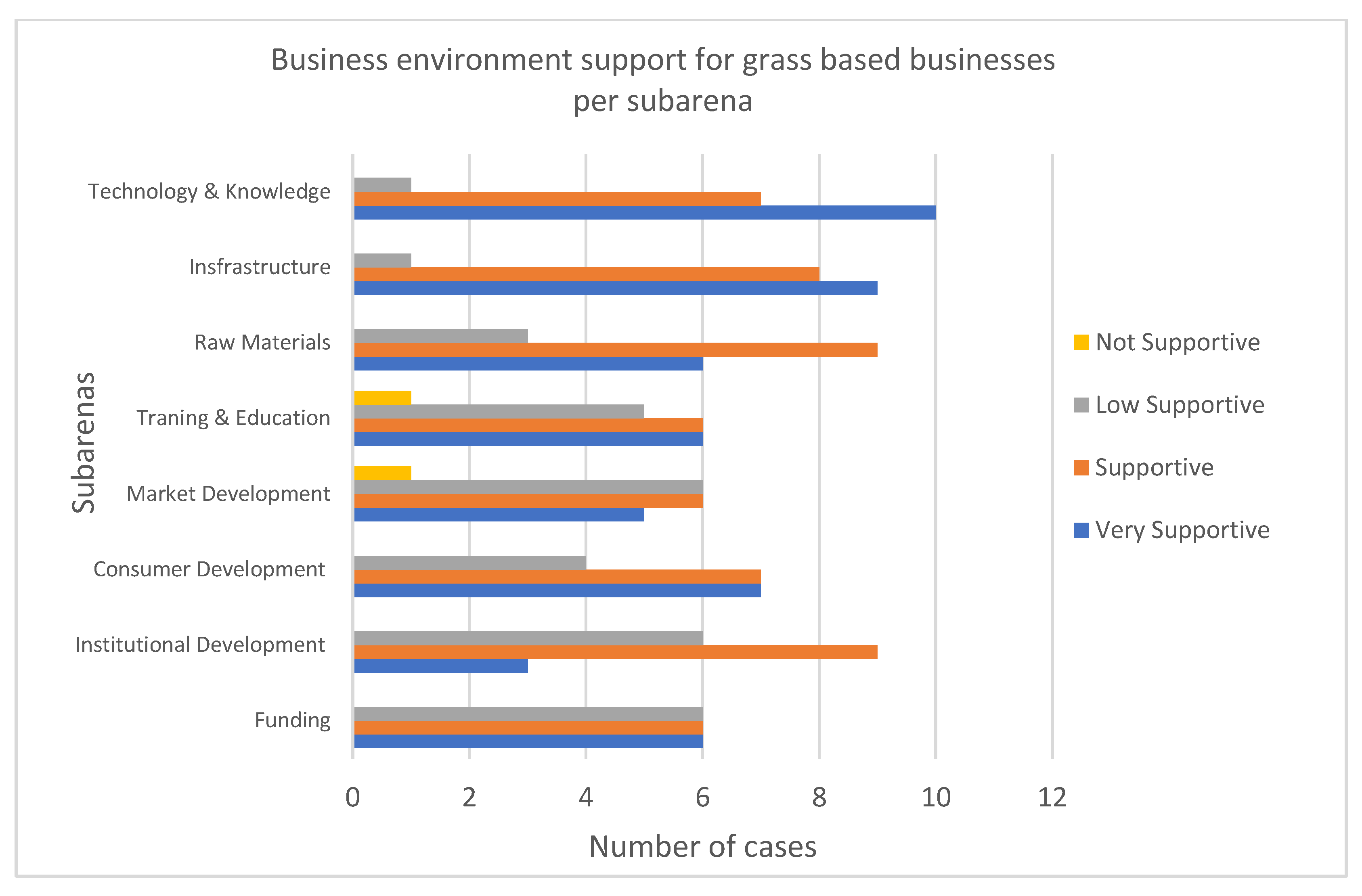
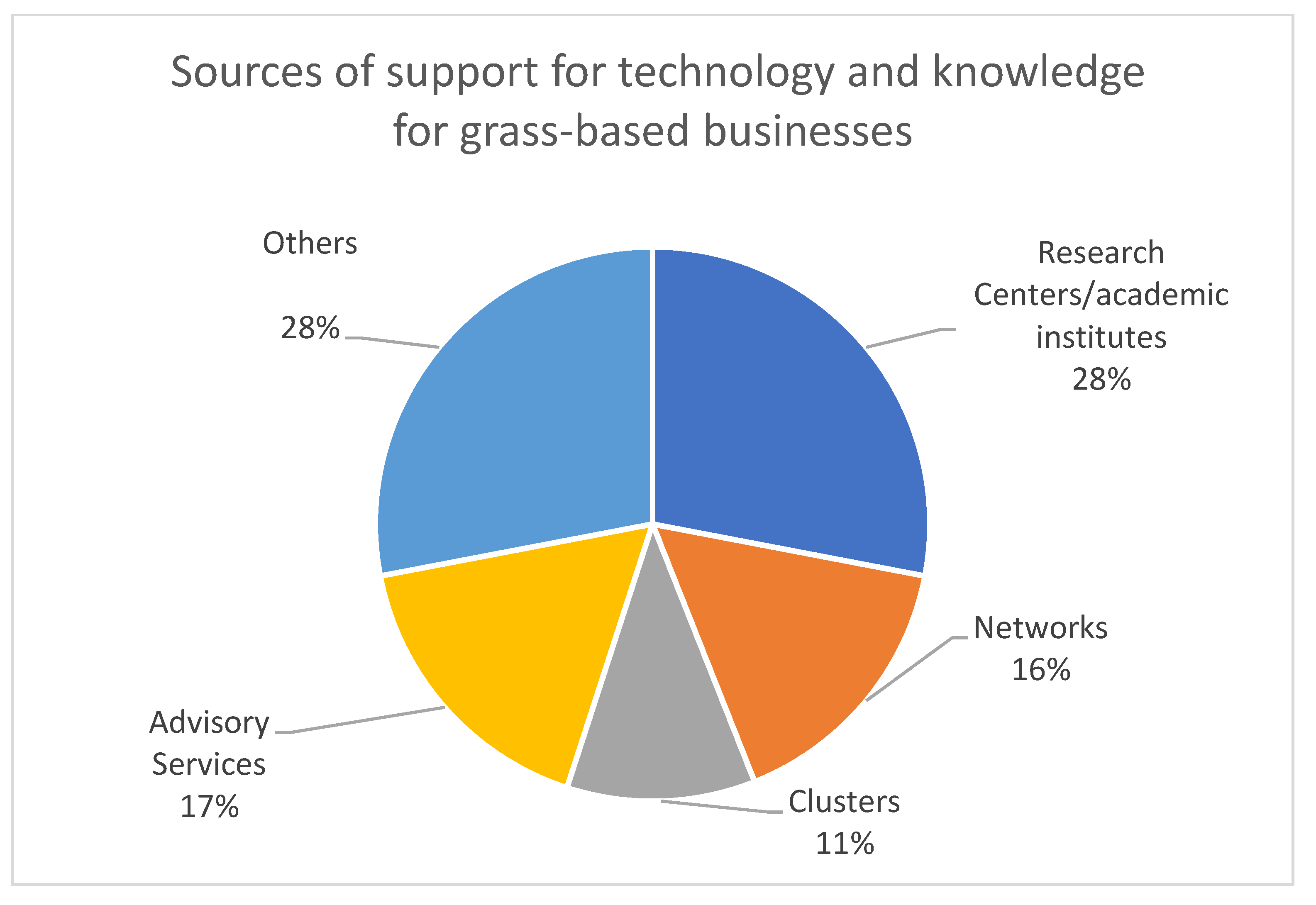
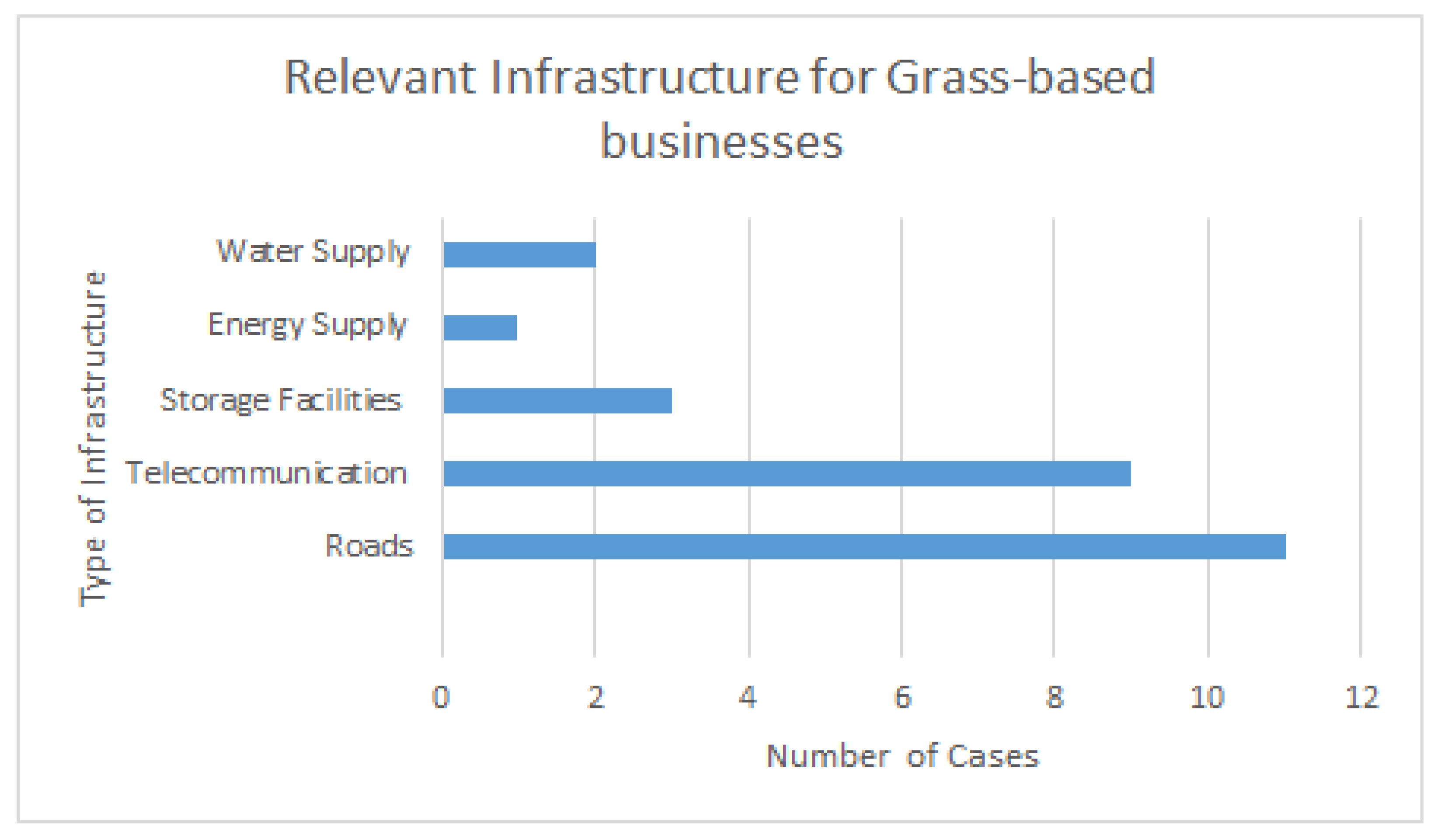
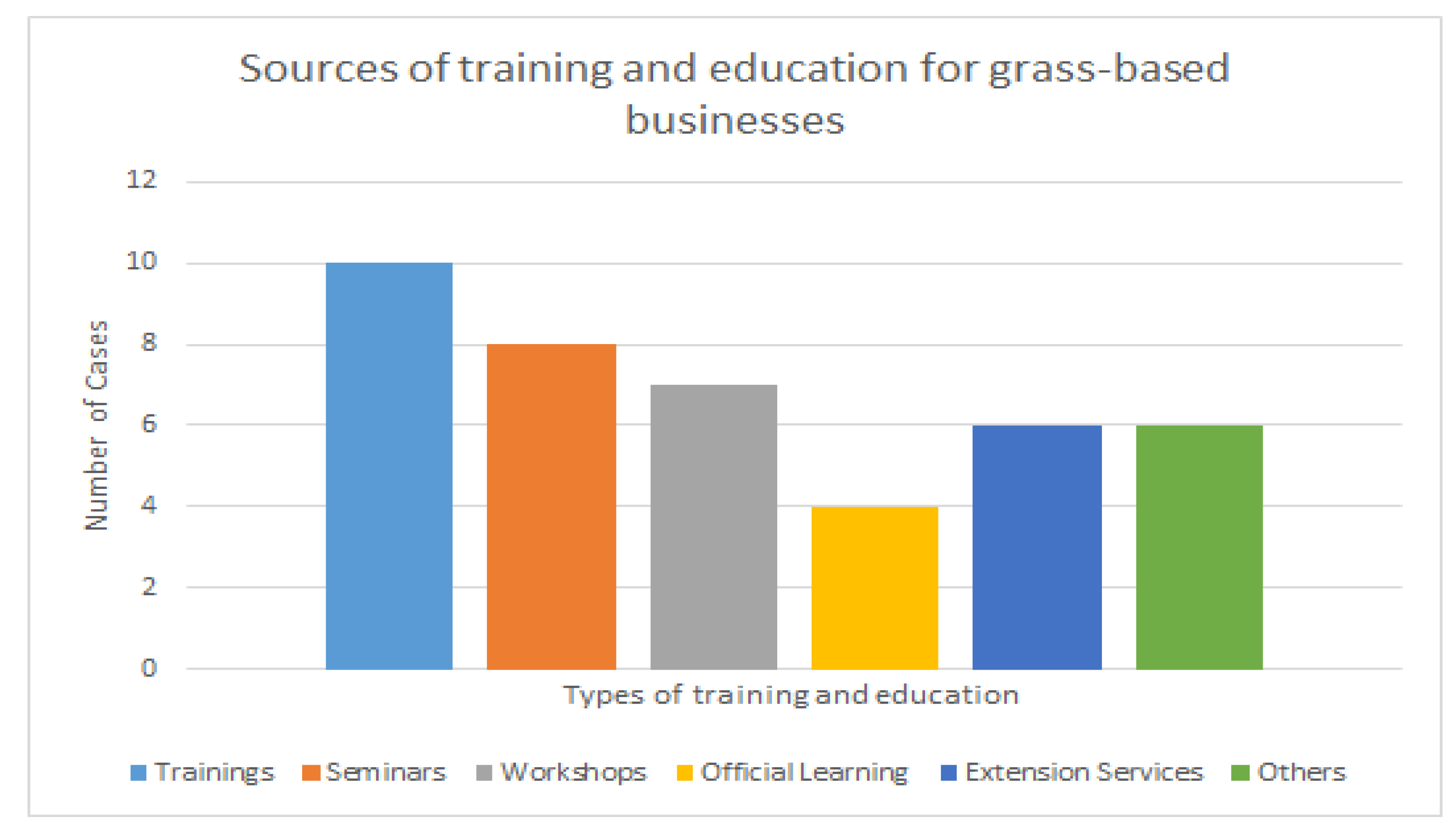
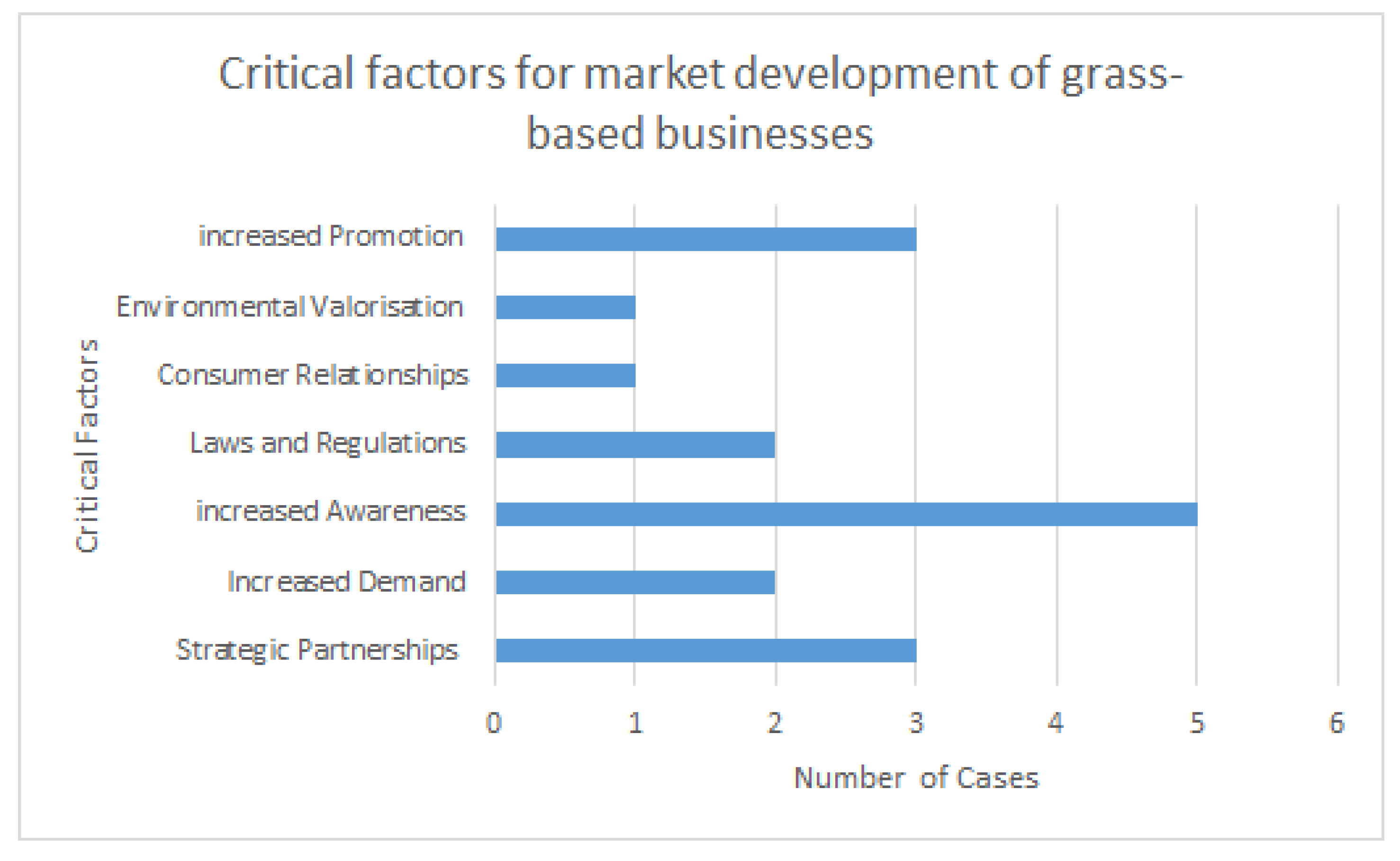
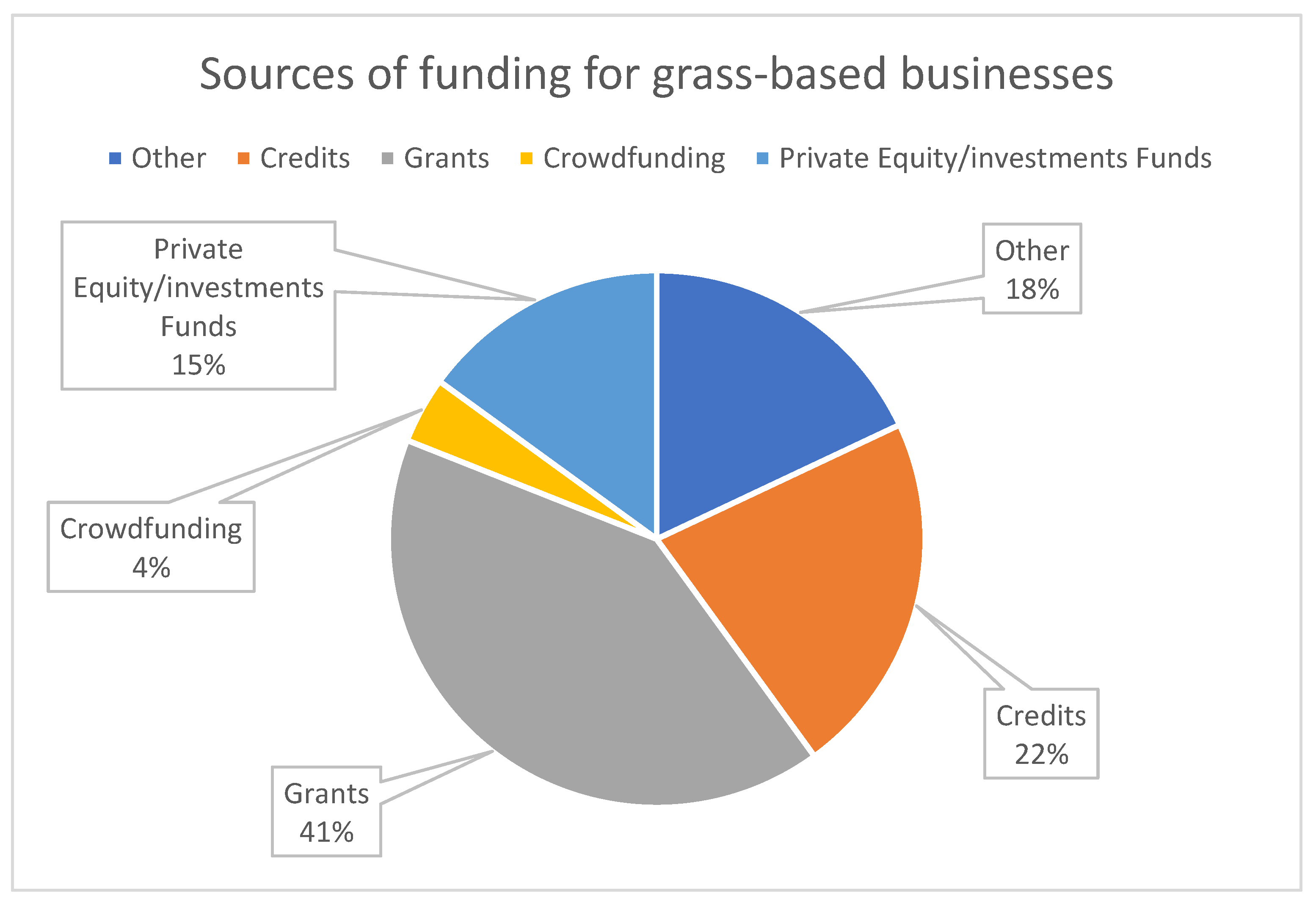
| Grass-Based Product | Location | Case ID |
|---|---|---|
| Paper | Germany, Romania | 1, 2, 7, 10 |
| Fiber Boards (Construction and Insulation) | Germany, Switzerland | 1, 14 |
| Straws | Germany | 1 |
| Fertilizer (Soil Amendment) | Netherlands, Romania | 4, 11 |
| Plastic | Germany | 5, 16, 17 |
| Feed Protein | Denmark, Netherlands | 6, 15 |
| Bioenergy | Germany, Romania, Netherlands, Sweden | 8, 9, 15, 18 |
| Seeds | Denmark | 13 |
Publisher’s Note: MDPI stays neutral with regard to jurisdictional claims in published maps and institutional affiliations. |
© 2021 by the authors. Licensee MDPI, Basel, Switzerland. This article is an open access article distributed under the terms and conditions of the Creative Commons Attribution (CC BY) license (https://creativecommons.org/licenses/by/4.0/).
Share and Cite
Orozco, R.; Mosquera-Losada, M.R.; Rodriguez, J.; Adamseged, M.E.; Grundmann, P. Supportive Business Environments to Develop Grass Bioeconomy in Europe. Sustainability 2021, 13, 12629. https://doi.org/10.3390/su132212629
Orozco R, Mosquera-Losada MR, Rodriguez J, Adamseged ME, Grundmann P. Supportive Business Environments to Develop Grass Bioeconomy in Europe. Sustainability. 2021; 13(22):12629. https://doi.org/10.3390/su132212629
Chicago/Turabian StyleOrozco, Richard, María Rosa Mosquera-Losada, Javier Rodriguez, Muluken Elias Adamseged, and Philipp Grundmann. 2021. "Supportive Business Environments to Develop Grass Bioeconomy in Europe" Sustainability 13, no. 22: 12629. https://doi.org/10.3390/su132212629
APA StyleOrozco, R., Mosquera-Losada, M. R., Rodriguez, J., Adamseged, M. E., & Grundmann, P. (2021). Supportive Business Environments to Develop Grass Bioeconomy in Europe. Sustainability, 13(22), 12629. https://doi.org/10.3390/su132212629







